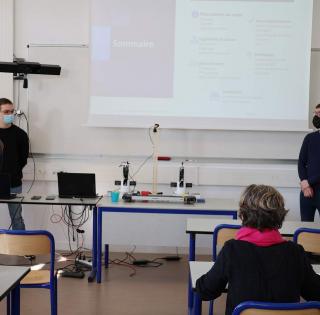
Détails de formation
#Conception de Systèmes Numériques
Objectifs
Telecommunication
"The key is the Internet. The United States is by far the most advanced country in this new digital culture, so we have to be there. The Internet is the heart of this new civilization, and telecommunications are the nervous system, or circulatory system." (Carlos Slim is a Mexican business tycoon, investor, philanthropist, and engineer. From 2010 to 2013, Slim was ranked as the richest person in the world by the Forbes business magazine.)
I will set big goals for this country as president - some so large that the technology to reach them does not yet exist. I will recruit new teachers and make new investments in rural schools, we’ll connect all of America to 21st century technology and telecommunications. Barack Obama.
From the beginning of last century, telecommunication has been one of the very important sciences and challenges.
It has also been an important factor of economic development. In addition, telecommunication is an important area of professional growth.
Synchronization:
According to OxFord Dictionary: Synchronization is the operation or activity of two or more things at the same time or rate; Or th adjustment of a clock or watch to show the same time as another.
In Computing : The synchronization is defined as the action of causing a set of data or files to remain identical in more than one location.
Why should we study synchronization approaches?
In many applications, the synchronization is a must (Robotics, Remote Surgery, etc).
In Wireless Communications and networks, synchronization approaches have been developed to increase the transmission rate.
These methods are required in various files and applications such as in video transmission, or TV broadcasting: Indeed, would you like to have the image on your TV screen starting from the middle of the screen? Or would you like to have the even and odd lines of the TV images in an asynchronous way?
MultiUser Radio Communications: Multiplexing Techniques:
In the year 1870, the multiplexing technique is invented first in telegraphy, and at present, it is extensively used in communications.
Multiple Access: Using several channels, many Users should communicate or transmit their data. Multiple Access can be as well a remotely sharing of a physical communication channel by several users in dispersed locations. The users’ needs can be quite different.
Multiplexing: Users should communicate using the same physical channel without interfering each other. "Multiplexing is the process of combining multiple signals into one signal over a shared medium." Multiplexing is the sharing of a channel by users confined to local site, for example telephone centers. Multiplexed system: Users requirements are normally fixed.
The process of the multiplexing can be done by a device called "MUX" or "Multiplexer". At the receiver, another device should be used "DEMUK" or "deMultiplexer". If many Mobil Stations (MS) would like to contact the same Base Station (BS) than they will face interference problems. The main idea of Multiplexing is to use orthogonal transmitted signal.
PS: les supports sont en Anglais; mais la formation pourra être en Anglais ou en Français.
"The key is the Internet. The United States is by far the most advanced country in this new digital culture, so we have to be there. The Internet is the heart of this new civilization, and telecommunications are the nervous system, or circulatory system." (Carlos Slim is a Mexican business tycoon, investor, philanthropist, and engineer. From 2010 to 2013, Slim was ranked as the richest person in the world by the Forbes business magazine.)
I will set big goals for this country as president - some so large that the technology to reach them does not yet exist. I will recruit new teachers and make new investments in rural schools, we’ll connect all of America to 21st century technology and telecommunications. Barack Obama.
From the beginning of last century, telecommunication has been one of the very important sciences and challenges.
It has also been an important factor of economic development. In addition, telecommunication is an important area of professional growth.
Synchronization:
According to OxFord Dictionary: Synchronization is the operation or activity of two or more things at the same time or rate; Or th adjustment of a clock or watch to show the same time as another.
In Computing : The synchronization is defined as the action of causing a set of data or files to remain identical in more than one location.
Why should we study synchronization approaches?
In many applications, the synchronization is a must (Robotics, Remote Surgery, etc).
In Wireless Communications and networks, synchronization approaches have been developed to increase the transmission rate.
These methods are required in various files and applications such as in video transmission, or TV broadcasting: Indeed, would you like to have the image on your TV screen starting from the middle of the screen? Or would you like to have the even and odd lines of the TV images in an asynchronous way?
MultiUser Radio Communications: Multiplexing Techniques:
In the year 1870, the multiplexing technique is invented first in telegraphy, and at present, it is extensively used in communications.
Multiple Access: Using several channels, many Users should communicate or transmit their data. Multiple Access can be as well a remotely sharing of a physical communication channel by several users in dispersed locations. The users’ needs can be quite different.
Multiplexing: Users should communicate using the same physical channel without interfering each other. "Multiplexing is the process of combining multiple signals into one signal over a shared medium." Multiplexing is the sharing of a channel by users confined to local site, for example telephone centers. Multiplexed system: Users requirements are normally fixed.
The process of the multiplexing can be done by a device called "MUX" or "Multiplexer". At the receiver, another device should be used "DEMUK" or "deMultiplexer". If many Mobil Stations (MS) would like to contact the same Base Station (BS) than they will face interference problems. The main idea of Multiplexing is to use orthogonal transmitted signal.
PS: les supports sont en Anglais; mais la formation pourra être en Anglais ou en Français.
Pédagogie
La stratégie de cette formation est basée sur des méthodes d'apprentissage pédagogiques innovantes et dynamiques. Ainsi la pédagogie retenue s’articule autour de séminaires et des réflexions collectives autour de thèmes ciblés et progressifs.
Niveau du stage
Base
Dispositif d'évaluation
Evaluation à chaud en fin de formation par les stagiaires. Transmission au client, du compte-rendu d’évaluation et des feuilles d’émargement en complément de la facturation. Les attestations de stage sont remises directement aux stagiaires à la fin de la session de formation. Les stagiaires ou le responsable Formation Continue sont susceptibles de recevoir par mail, un « questionnaire de satisfaction à froid » quelques mois après le déroulement de la formation
Programme détaillé
Synchronization:
- Introduction & Background
- Syncgronization & Distance Estimation
- Time Division Multiple Access (TDMA) Protocols
- Synchronization Protocols
- Introduction to Electronic Warfare
- Carrier Synchronization
- PLL & similar algorithms
- Symbol Synchronization
Multiplexing:
- Introduction & Background
- Multiple-Access Techniques:
- 2.1- TDMA
- 2.2- SOTDMA
- 2.3- FDMA
- 2.4- OFDM
- 2.5- WDMA
- 2.6- SDMA
- 2.7- CDMA
- 2.8- PDMA
- 2.9- PCMA
- Introduction to Satellite Multiplexing Techniques
- Introduction to Wireless Communcation Specificities
- Network Multiplexing Protocols
- 5.1- What is the MAC?
- 5.2- ALOHA
- 5.3- CSMA
- 5.4- Hiper Lan Mac standard
- 5.5- IEEE 802.11 MAC Standard
- Introduction to Cognitive Radio: Non Cooperative Techniques
Responsable de la formation et équipe pédagogique
Ali Mansour
Enseignant-chercheur
A travaillé ou enseigné au sein de plusieurs universités nationales et à l’étranger (Japon, Australie, Espagne, Arabie Saoudite et Liban),
Membre du Pôle STIC de l’ENSTA Bretagne.
contact
Adélaïde Gaudron
Formation continue
formation_continue@ensta-bretagne.fr
02 98 34 87 01
Actualités











